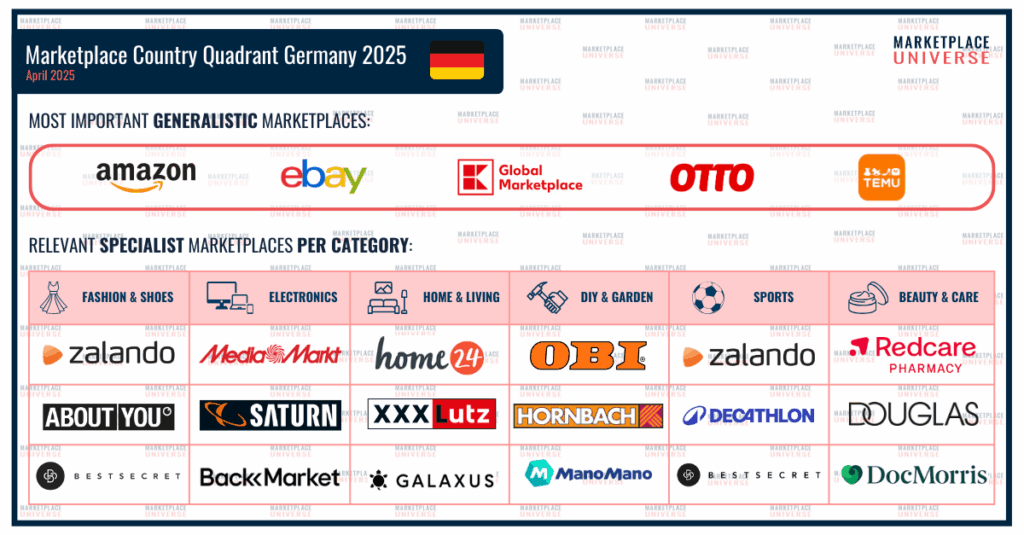
These are the 23 most important marketplaces for selling to Germany!
Last update: 25.04.2025
Germany continues to be the heavyweight of European e-commerce. With an estimated GMV of €86 billion in 2024 (up +1.1% YoY), a population of 83 million, and a household income of €43,000, the German online market remains Europe’s largest in absolute terms. Yet despite its scale, growth has slowed – a reflection of the broader economic crisis that continues to weigh on consumer confidence.
Spending is cautious, purchase decisions are delayed, and brands are under pressure. But that doesn’t mean the market isn’t worth watching – quite the opposite. Germany’s platform landscape is mature, deeply integrated, and increasingly essential for success in this market. With 54% of online sales (2023 data) taking place on marketplaces and Amazon reaching 82% of online users monthly, Germany remains one of the most marketplace-driven markets in Europe.
Our newly updated Marketplace Country Quadrant Germany 2025 reflects the 23 most relevant marketplaces for sellers looking to navigate this tough but strategically critical market.
🛒 The Generalists
The German e-commerce market continues to be heavily dominated by generalist platforms.
At the top stands Amazon – the default marketplace for most consumers, present in almost every category, and the number one online store by GMV. eBay maintains its position as a key secondary platform, especially for electronics and refurbished goods. Otto continues to build on its established closed marketplace model, which has seen strong growth in 2024—outperforming its own retail business, which declined significantly.
Kaufland, meanwhile, has scaled its marketplace model significantly and remains an important player. Finally, Temu is rising fast, though with less impact than in markets like France or Spain. The Chinese low-cost platform is meeting fierce competition and considerable scepticism among German brands and retailers, many of whom are hesitant to list on the platform despite its consumer growth.
🧩 The Specialists by Category
👗 Fashion
Zalando continues to lead the fashion category, closely followed by About You. New in this year’s quadrant is Best Secret, which has grown significantly and recently took over Breuninger’s marketplace business. Breuninger itself is no longer listed but remains a notable number 4 for premium fashion brands.
💻 Electronics
The electronics category remains stable, with no changes in this year’s quadrant. MediaMarkt and Saturn, both operated by the Ceconomy group, are the strongest players, with BackMarket adding a powerful offer for refurbished electronics.
🛋️ Home & Living
Here we see a significant change: Wayfair, once a prominent name, has completely shut down its German online shop and has therefore been removed from the quadrant. Taking its place is Galaxus, which has gained market share through strong marketing and a growing product range. The top three now are: Home24, XXXLutz, and Galaxus. Breuninger would rank as a strong number 4 for home brands with a lifestyle focus.
🧰 DIY & Garden
Germany’s DIY sector is still developing its marketplace maturity. In this year’s update, Obi and Hornbach remain on the list, while ManoMano replaces Bauhaus, whose marketplace hasn’t yet launched. Market sources suggest a launch could happen in summer 2025, so this might change in future updates.
🏃 Sports
No changes in sports: Zalando, Decathlon, and Best Secret continue to lead the way. Zalando’s sports offering has grown more relevant over time, especially in urban and casual segments.
💄 Beauty & Care
There is a shift in this category. Zalando, which had previously been active here, has reduced its marketplace efforts in Beauty & Care, and has been replaced by DocMorris – a growing name in the online pharmacy and wellness space. The top three are now: Redcare Pharmacy, Douglas, and DocMorris.
🔍 A Mature Market, Slow to Change
Compared to other European markets, Germany’s marketplace landscape remains remarkably stable. It is one of the hardest markets for newcomers to break into, and even platforms that are growing rapidly elsewhere – such as Shein – have not been able to achieve the same traction here. While Shein dominates fast fashion in Spain or France, it plays only a minor role in Germany.
This speaks to both the conservatism and the maturity of the German market. Consumers are loyal, value-oriented, and cautious. Retailers move slowly, and many take a wait-and-see approach to new platforms. Even Temu, despite aggressive growth strategies, faces heavy scepticism from German sellers and partners.
That said, the size and strength of the German e-commerce sector still make it a critical pillar in any international marketplace strategy. The key is understanding which platforms matter — and why.
📣 Want to add your voice?
This is the latest version of our Marketplace Country Quadrant Germany, and like all of our quadrants, it’s informed not just by data — but by community input. Have we missed something? Are you seeing different trends? We’re always happy to hear from marketplace professionals, sellers, and partners in the field.
Looking for the most important marketplaces in another country or a specific category? Check out all our Marketplace Quadrants here!